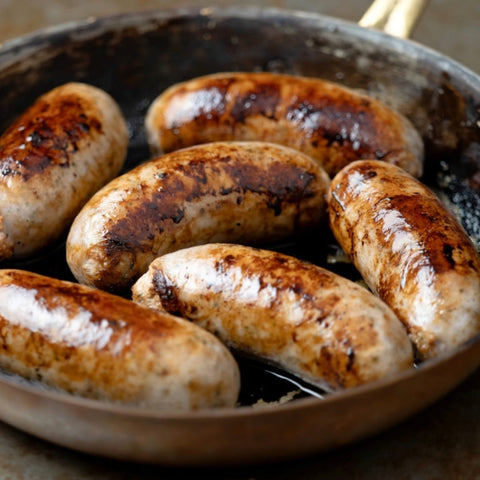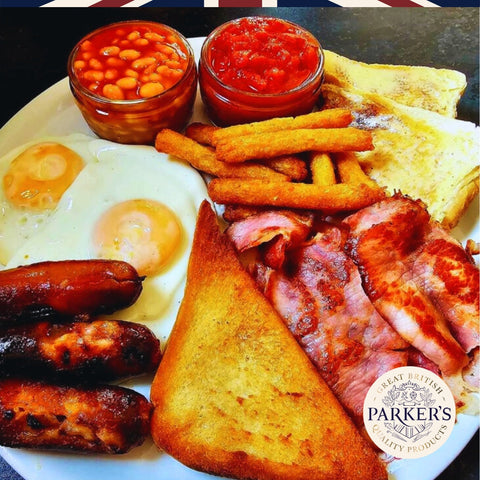The Surprisingly Juicy History of British Sausages
Everything you didn’t know you needed to know about the great British banger.
Say the words British sausages and you’re instantly transported to a proper fry-up, a warming plate of bangers and mash, or the irresistible sizzle of Bonfire Night. But the history behind our beloved banger is every bit as mouthwatering as the sausages themselves.
Ancient Origins (Yes, Really)

While we like to think we perfected the sausage, the earliest sausages can be traced all the way back to Ancient Mesopotamia. The history of the sausage is a tale of ingenuity, survival, and cultural adaptation stretching back thousands of years. While we proudly celebrate Britain's sausage-making traditions, the story begins in ancient Mesopotamia around 3000 BCE, where resourceful Sumerian cooks first stuffed chopped meat into animal intestines, creating the earliest known precursors to our modern sausages.
This practical method of preserving meat traveled through the ancient world, with the Romans later refining the technique and introducing spiced, smoked varieties to Britain during their occupation. However, the British Isles already had their own sausage traditions brewing - the native Celts were making primitive blood sausages resembling today's black pudding long before Roman influence.
As centuries passed, the Anglo-Saxons embraced sausage-making with characteristic enthusiasm, transforming it into a dietary staple across all social classes. The medieval period saw sausages become particularly important as an efficient way for peasants to utilize every part of the animal, with regional variations emerging across Britain.
The very word "sausage" reveals this layered history, evolving from the Latin "salsus" meaning salted, morphing into the Old English "sawshire," before settling into its modern form - a linguistic journey that mirrors the sausage's own transformation through time and cultures. This humble food's enduring popularity through wars, famines, and social changes stands as testament to its fundamental place in British culinary heritage and the human story of making the most of available resources.
Why 'Banger'?
The term ‘banger’ dates back to wartime Britain, when meat was in short supply and sausages were padded out with water and breadcrumbs. Fry one in a hot pan and it’d often go off with a bang—hence the nickname. Fortunately, things have improved since then, though we kept the name (and the love affair).
Regional Sausages Worth Writing Home About

What makes British sausages truly special? The sheer variety. Every corner of the country seems to have its own take on the perfect sausage:
- Cumberland sausages: Coiled like a spring and peppery to boot, these Lake District legends are big on flavour and portion size. This hefty sausage dates back to the 16th century, when German miners settled in Cumbria and brought their spiced sausage-making skills with them.
- Lincolnshire sausages: With sage leading the charge, this herby classic from the East Midlands is a favourite for a reason, and that unmistakable earthy aroma of sage is a nod to the region’s lush herb gardens.
- Old English: These plump, pale sausages were the backbone of working-class diets during the Industrial Revolution, providing affordable nourishment to factory workers and farmers alike. Today, they remain a cornerstone of proper pub grub, whether served with buttery mash and onion gravy or tucked into a crusty white bap with a smear of English mustard. A comforting reminder of Britain's culinary roots - unpretentious, satisfying, and steadfastly traditional.
But the British sausage repertoire stretches far beyond these classics. In Wales, you’ll find Welsh lamb sausages, where tender mountain lamb is blended with leeks and thyme, capturing the essence of the countryside in every bite. Scotland offers its Lorne sausage (or "square sausage"), a spiced beef-and-pork loaf sliced into neat rectangles—a staple of the full Scottish breakfast. Over in Ireland, white pudding (a cousin to black pudding, minus the blood) brings its own delicate spicing to the fry-up.
And let’s not forget the chipolata, Britain’s daintier sausage, which found fame as a Christmas dinner essential but works just as well year-round, especially when wrapped in bacon (as the pigs in blankets that dominate holiday tables).
The British Sausage Renaissance
Once seen as a breakfast basic, the British sausage has undergone something of a glow-up. While the good old pork banger remains front and centre, today’s sausage scene includes beef, lamb, venison, gluten-free, and even plant-based options—though we’ll always have a soft spot for the classics.
At Parker’s, we handmake our British sausages right here in the States using the finest local pork and proper British seasoning blends. No nonsense. No shortcuts. Just a brilliantly balanced banger that holds its own in any breakfast, bap, or barbecue.
So Why Do British Sausages Still Matter?
Because they’re not just food—they’re tradition. Comfort. A reminder of home. Whether you’re a British expat yearning for the real deal or a curious American discovering what a sausage should taste like, there’s nothing quite like a proper banger.
They’re hearty without being heavy. Classic without being boring. And always ready to take pride of place on your plate.
Time to Tuck In?
If you’ve got this far and your stomach’s rumbling, we salute you. Why not explore our full range of handmade British sausages and bring a little taste of tradition to your next meal?
Made to British standards. Loved across America.




Comments (1)
Just received my first order of pies, sausage and desserts.
Excellent Quality.
My wife has Celiac Disease (Gluten Free)…
Any chance of making the pies with gluten free pastry?